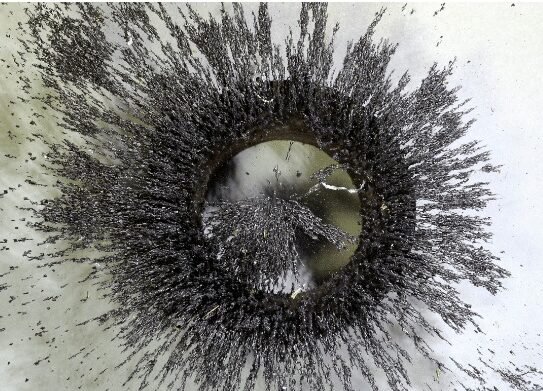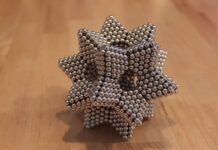Demagnetization though the slow process, forces the magnet to lose its strength over time. So the answer to the question do magnets wear out is that it happens, and the so-called permanent magnet loses its power ending up wearing out. That said, a magnet, as time passes, loses its strength. This phenomenon happens due to several reasons. The permanent magnets also have magnetic domains where the atoms have electrons aligned with each other. Alignment gets damaged over time, and so this leads to the weakness of the level of magnetism.
Table of Contents
Can magnets wear out? The justified answer

Yes, they can! When external influence is absent, the commercially viable magnet alloy remains magnetic for around a hundred years. The resulting field, however, starts degrading over time from the aging effects. But most of the time, it remains an effective magnetic field source. That said, the magnets that find use in real-world applications usually experience external demagnetizing conditions. The partiality magnetizing magnets also significantly impact the operational performance leading to failure in the field.
The primary role: the geometry of the magnet
When you’re questioning do magnets wear out, remember the magnet alloy never desires to get magnetized. When the magnet gets magnetized at some point, it puts the higher energy state. The magnet always attempts to the reduction of the energetic state and becomes demagnetized.
Keeping the magnet in the magnet is the condition right after the external magnetizing field find removal is something that makes it special as the permanent magnet alloy. The regular Steel becomes the strong magnet. However, the induced field of the Steel immediately degrades to completely zero when the external magnetizing field finds its removal.
Again in the magnetic alloy, there is a mechanism that allows the sustaining of the induced magnetism. However, this mechanism has limitations. The geometry of the magnet gives a steady influence to the alloy ability of the magnet. Rather, it finds demagnetizing from the number of external factors and internal forces. The geometry of the magnet sometimes finds reduction to the simple ratio that is zero.

A horseshoe magnet requires being made by heating a ferromagnetic alloy above a certain temperature, placing it inside a magnetising coil and allowing it to cool. The effect is felt in a manner that the coil’s strong magnetic field makes microscopic regions inside the metal crystal, referees to as magnetic domains. They line up their magnetism with each other resulting in a powerful new magnet.
During everyday use, the magnet is susceptible to getting dropped and banged about that jostles the magnetic domains and they gradually become jumbled up. The more often this happens, the weaker the magnet becomes.
A radioactive element is loaded with atoms with an unstable nucleus leading it to emit radiation and become more stable. The amount of radiation emitted is dependent on the number of unstable atoms that are left. Over time, fewer unstable atoms are there and so the sample becomes less radioactive as a result.
Both the weakening of the horseshoe magnet as well as radioactive decay involve a system inevitably moving from a higher energy state toward a lower one.
The magnetic field in a permanent magnet tends to decay over time, but “not with a predictable half-life as with radioactivity”.
In this regard, it’s worth noting that “Permanent” or ferromagnetic materials have tiny regions, or domains, of 0.1 to 1 millimetre in length. These domains feature the magnetic fields of adjacent atoms pointing in the same direction to create miniature magnets. When the majority of the domains in a piece of metal are aligned with one another, the whole material behaves as a magnet.
In case the magnet is exposed to an opposing magnetic field, some domains preferentially align with the external field, reducing the magnet’s overall strength. The domains randomly reorientate when energy is imparted to the magnet, usually when dropped or struck sharply.
Similarly, a magnet gradually loses magnetism when it is heated. At a temperature referred to as the Curie point – this varies in different metals, around 770° in iron – permanent magnetism is lost altogether.
Over a longer period, random temperature fluctuations, alongside the stray magnetic fields and mechanical movement cause magnetic properties to decay. However, this effect is very slow. When one handles and stores magnets carefully and stored with metal keepers between their poles to constrain the magnetic fields, they last for many years. Modern magnets composed of rare earth alloys last for centuries.
Do magnets wear out over time? -a highlight on the volume loss
The prominent performance degradation of the magnet comes with the volume loss that happens due to the reduction of the volume of the magnet. The mechanical impact can also be the reason behind this. The portion of the magnet is vulnerable to fracture from the main body that leads to volume loss due to corrosion. Besides, the loss of performance also has a close relation to the fracturing operation. Such a condition is enough for degrading its quality.
Do magnets wear out: the factors forcing the loss of magnetization
Several factors are responsible for degrading power of magnet.
Demagnetizing due to the elevated temperatures
When you’re questioning can a magnet wear out, remember that no magnet retains the strength permanently. The magnets that are exposed to the heat are responsible for the loss of strength. With time it cannot find the recovery of this strength. Magnets lose strength when they heat up. But this happens as long as they are not taken to a certain operating point.
When the magnet finds the attainment of the operating point temperature, then the percentage of the volume of the magnet finds demagnetization. In this case, the magnetic loss doesn’t find recovery without the high magnetizing of the magnet. Remember that the operational point is always geometry-specific. Most of the magnet providers usually have the specified maximum operating temperature for the various grades.
You can remagnetize a magnet by bringing it into contact with a strong or permanent magnet. You don’t have to worry about the weakened magnet because it can get back the magnetic force.

This usually happens with the magnet alloy. But such operating temperatures also always do not work out. The advertised maximum operating temperature isn’t always a sufficient amount to ensure the elevation of the temperature. Temperature variation is the prime reason behind causing magnets to lose magnetic charge. Depending on the extremity of the temperature changes, the losses prove to be temporary or permanent.
Some magnets regain this force when they come back to optimal temperature. However, the phenomenon isn’t the same for every type and material. With magnetization, you can expect it to regain most or all of the losses. However, note that heating above a point causes permanent loss of magnetic charge, and that’s practically unchangeable.
External field leading to the oxidation
Do magnets wear out? Magnet alloy finds magnetization with the intense magnetic field established in the same direction as that of the magnet’s orientation. When such a magnetized magnet is made opposite to the orientation, it automatically finds demagnetization.
The demagnetization always reduces the effective field of the magnet while also degrading the performance of the magnet. The external magnetizing field always originates from the field that finds creation due to the electromagnets or the coils or sometimes a neighboring permanent magnet.
External Charges
Do magnets lose power? They do! And external charges are one of the many reasons. Some magnets do not have protection from outside magnetic fields. These magnets are the ones that are vulnerable to loss of magnetic charge. Alnico is the one most susceptible to multiple external charges. Environmental degradation and improper storage cause the opposing forces to increase, thus leading to the loss of the magnetic charge.
Shock or vibration usually does not cause the loss of magnetic strength. Exceptions are chipping, breaking, Cracks, and erosion that decrease the mass of the magnetized material. Industrial usage- radiation usually proves to be the concern in the preservation of magnetic charge. Exposure to moderate or high radiation can also degrade the quality.
Intrinsic coercive force
Intrinsic coercive force refers to the magnet alloy’s ability to withstand heat and demagnetization. The operating temperature finds increases with the increase in the intrinsic coercive force. That said, the concept is true for the ability of the magnet to withstand the external magnetizing field. The Intrinsic coercive force always adds to the cost, which is why the Intrinsic coercive force should always match the application.
Aging magnet
The passage of time weakens the strength of a magnet, but it’s worth noting that changes are very slow. External factors will have a greater total effect.
Reluctance Changes
Operating slope modification means that the variance distorts the magnetic charge. There’s a role of displacement from a circuit. Besides, the chances are higher with the changing the magnet properties while in use. The level of magnetic charge reduction is dependent upon how extreme the alterations are. Besides, there is also the role of the properties of the magnet.
Does magnetism decay over time?
A common question among magnet users is do magnets lose their magnetism over time. The simple answer is that, with time, every magnet degrades in power. Ferromagnetism has its origin at the atomic level. The magnetic field can exist in the presence of an electric current, and when it comes to piece of iron, atomic-sized electric currents are there in every direction. Still, putting that piece of iron in a strong magnetic field causes atoms to line up.
This property causes iron to become magnetized. Horseshoe magnet finds origination this way. At any temperature above absolute zero, the atoms in the magnet move around and randomize positions. The concept justifies that any magnet will slowly weaken. During this stage, heating or dropping a magnet hastens this process.
Besides, everyday use causes the magnet vulnerable to accidental drops. Magnetic domains at this stage become jumbled up. The magnet becomes weaker over time due to such issues.
The magnetic field in a permanent magnet isn’t vulnerable to decay over time. “Permanent” or ferromagnetic materials come with tiny regions, or domains, of 0.1 to 1 millimeter. Magnetic fields of adjacent atoms in such domains point in the same direction, leading to creating the miniature magnets.
Magnet is exposed to an opposing magnetic field reduces the magnet’s overall strength. Dropped or struck magnet is also much vulnerable to demagnetization. Besides everything else, it’s worth noting that the random temperature fluctuations, mechanical movement, stray magnetic fields cause magnetic properties to decay.
Carefully handled and stored with metal keepers between poles can even last for centuries.
Why don’t magnets last forever?
So-called permanent magnets constructed from materials made up of magnetic domains, have atoms with electrons that has spins aligned with each other. This alignment is susceptible to damage over time, as the result of heat and stray electromagnetic fields. Such factors weaken the level of magnetism.
FAQs
Yes, as time passes, all magnets lose part of their strength. Thermal energy causes the disorientation of the atomic magnetic momenta. Besides, factors like magnetic field H opposite to the magnetization of the magnet cause speedy demagnetization.
Rare earth magnets, too loses part of their strength. Thermal energy and forces applied opposite to the magnetization cause the magnet to wear out.
Magnets lose power over time, but only the natural magnets take longer to lose their power.
A permanent magnet used in optimum working conditions holds magnetism for years and years.
The alignment gets damaged over time, as the result of heat and stray electromagnetic fields. It is responsible for weakening the level of magnetism. However, a modern samarium-cobalt magnet takes around 700 years to lose half its strength.
Loudspeakers eventually wear out as a result of the mechanical wear. This issue particularly happens in the surround/suspension that connects the cone/diaphragm to the basket/housing. Environmental factors are responsible for wearing out the speaker with enough time and exposure. Extended high-level audio signals are responsible for wearing out electrical components.
A worn out or faulty brake magnet is responsible for impacting the trailer’s power to stop. Some magnet problems will be noticeable just by looking at the magnet. Also, at times there may also be electrical problems that affect performance. An impaired brake magnet can lead to weak or surging brakes.
Yes, it does.
Extreme magnets wear when there are no holes or fewer than four holes. When the face of the magnet hole has worn, then it is time to replace the magnet.
Do neodymium magnets wear out?
The magnet that is partially demagnetized greatly influences the effective performance, causing field failure. Neodymium magnet, in this regard, loses around 5% magnetism for every hundred years. It’s worth noting that all magnets gradually wear out. Heating or dropping the magnet accelerates deterioration.
Do permanent magnets wear out?
Permanent magnets like sintered Nd-Fe-B stay magnetized for an indefinite period. However, such magnets too lose their strength with time. The phenomenon happens due to surrounding conditions like moisture and heat.
Do magnets lose their magnetism over time?
Yes, permanent magnets lose some amount of magnetism. The reasons behind it are mechanical damage, corrosion, and improper storage.
Why would a magnet stop working?
Magnetized magnet exposed to a strong magnetic established in opposition to the magnet’s magnetization makes the magnet demagnetized. Consequently, performance will therefore degrade.
Can you strengthen magnets?
After finding a very strong magnet, repeatedly rub it across the weakened magnet. A strong magnet, in that case, realigns the magnetic domains inside the weakened magnet.
Final words
You’ve got an answer to the query do magnets wear out. It is good to perform the actual analysis of the operating condition of the magnet. This consideration can make sure of giving you the relevant data regarding the grade of the magnet alloy. Besides, it also sticks to maintaining the magnet properties. Always reduce the chances of high temperatures, velocity, magnetizing field during its operation. However, one shouldn’t ever rely on the advertised temperature performance and value because they are not always the real.








